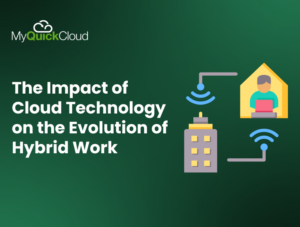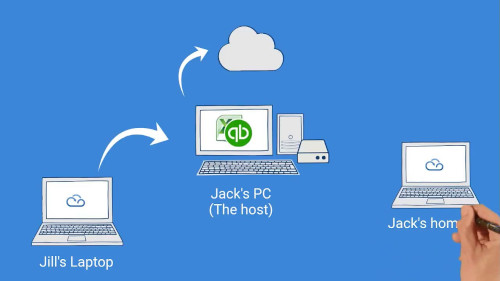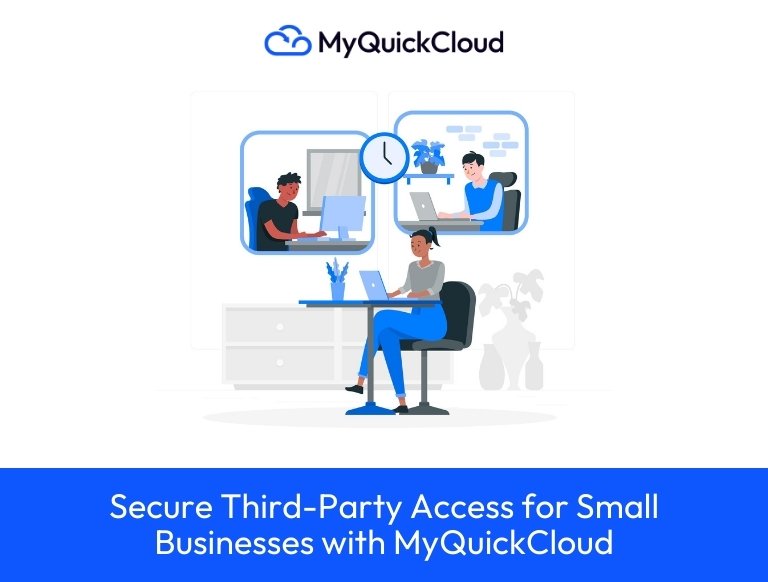In my role as Director at MyQuickCloud, one thing is clear, the days when everyone reported to a desk five days a week are long gone. In the realm of modern work, the adoption of cloud technology has brought about a transformative shift, reshaping the dynamics of hybrid work environments. While traditional offices were once viewed as the epicentre of productivity, the integration of cloud tools has paved the way for enhanced work-life balance and heightened efficiency, regardless of physical location. This shift really has proven to be a catalyst for increased employee satisfaction, improved productivity, and more effective team collaboration.
I’m proud to think that MyQuickCloud and its technology have been part of supporting companies to work better through this evolution, and we’re just getting started!
Latest research shows:
- In September 2023, 28% of workdays were worked remotely, a significant increase from 7% in 2019 (WFH Research, 2023).
- In 2023, nearly a third of respondents desired 5 days of work from home per week (30%) (WFH Research, 2023).
- In 2023, 70% of U.S. adults with remote work options felt a high level of trust in their managers when working remotely (Pew Research, 2023).
- By August 2023, 13% of full-time employees were fully remote, 57% were full-time on-site, and 30% were in a hybrid arrangement (WFH Research, 2023).

The most prevalent sectors in August 2023 for working from home were technology, finance, and professional & business services.
Information (including part of technology) had the most people working from home, followed by finance & insurance (2.22 days), and professional & business services (1.98 days).
Employee preferences and job requirements

87% of respondents considering a job change were interested in hybrid or fully remote positions in 2022.
Remote Work: Benefits
Remote work statistics reveal an interesting interplay between its advantages and challenges, opening up a range of experiences, highlighting employees’ flexibility and challenges. Organizations can reward their employees with a healthier work-life balance while increasing their reach by reducing the travel load and in-office time. As a result, companies with a global or regional workforce are always “on,” increasing productivity and providing 24/7 support. The best teams can be assembled regardless of geography.
In this section, we look at remote work productivity statistics, employer perks, and struggles encountered, in order to give you a comprehensive picture of remote work.
Let’s take a closer look at the benefits of remote working for employees:
In 2023, respondents cited flexibility as the top benefit of remote work (22% of respondents).
Next came the option to choose where they live (19%) and where they work (13%).
(Buffer, 2023)
The majority of remote workers reported that it was easier to focus on work (70% of respondents), manage stress (65%), and avoid distractions (50%).
(Buffer, 2023)
Moreover, in 2022, 30 percent of home-based employees reported being more engaged than hybrid employees (24%) or on-site employees (21%).
(Gallup, 2023).
Further, employees said that remote work brought them personal benefits in 2022. Respondents reported:
- 66% gained the flexibility to attend to family life
- 62% said remote work enhances their morale
- 61% experienced an improvement in their savings
Indeed, in 2022, nearly half of Australian workers (48%) said that remote working can help reduce the cost of living, while another 22% said it is about hybrid working.

When asked what they don’t miss about working in the office, 20% said that they do not miss the extra expense of food/coffee/transport – up from 12% in 2021.
Benefits provided by employers
Among the top benefits offered by employers to remote workers in 2023 were:
- Flexible hours (34% of employees and 40% of employers)
- Work-provided equipment (26% of employees and 34% of employers)
- Home office stipend (17% of employees and 20% of employers).
Employees and employers both benefit from flexible hours because they help them achieve a work-life balance.
Employees may prefer to use their own devices for work when it comes to equipment provided by their employers. Most employers, however, consider it important to provide equipment that aligns with their requirements and provides some level of control, such as device locking or activity monitoring.
(Forbes, 2023)
At MyQuickCloud, we enable employees to bring their own device (BYOD). If you already have a server or a computer you want to use as your cloud, you can just add it to your cloud and collaborate with your other users on it. This still provides employers with the control they desire, but gives more flexibility to the employee to utilise the tech they enjoy operating.
This flexibility via remote working is also reflected in equipment use. In 2022, over half (52%) of organizations allowed remote access to corporate applications from personal laptops. Nearly the same share (51%) allowed access from personal mobile devices.
Only 17% allowed access only from company-managed laptops.

Hybrid Workforce Pitfalls to Avoid
The drawbacks and complications of hybrid work are numerous. It may inadvertently create status differences and opportunity differences as a function of who is in the office and who isn’t,” if hybrid employees working remotely do not receive the same access to information, professional development, and recognition as those working on-site more often. The reason for this is distance bias, a natural tendency to value things and people nearby. Communication is key. And with tools such as Slack, Whatsapp or Office365, there’s no excuse if they are available to managers and teams.
The Bottom Line
Remote work has now become a mainstream arrangement, especially in technology, finance, and professional services, but at MyQuickCloud, we’re working across many industries.
A growing number of employees are preferring hybrid and fully remote positions, and some are even accepting salary cuts in exchange for such flexibility. Remote work benefits, such as flexibility and improved work-life balance, are counterbalanced by challenges, such as communication among teams, boundary-setting, and productivity concerns (especially for employers).
Although employers offer a variety of benefits, career growth and relationship-building remain issues. There are significant demographic and generational differences in access and preferences, with technology playing a crucial role in enabling remote work and presenting new challenges.
Statistical data on remote work reflects this ongoing evolution, highlighting the balance between the needs and preferences of the workforce, as well as the benefits and challenges of remote work.
Start accessing your applications remotely with MyQuickCloud today.





